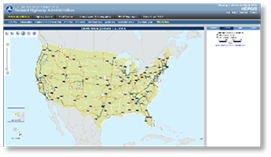Also in PDF (336KB)
As transportation practitioners look to apply the latest research and technologies in their communities, the Congestion Mitigation and Air Quality Improvement (CMAQ) Program, administered by the Federal Highway Administration (FHWA), serves as a flexible funding opportunity that can enhance local investments in transportation projects that improve air quality and reduce congestion. Alternative fuel vehicle (AFV) projects, including fleet conversions and refueling infrastructure, are one of the eligible project categories under CMAQ. In the past five years, $135 million in CMAQ funding went to more than 160 AFV projects.
AFV projects that receive CMAQ funding can also align with FHWA's Alternative Fuel Corridor Program. Established under the Fixing America's Surface Transportation (FAST) Act, the Alternative Fuel Corridor Program designates national electric vehicle charging, hydrogen, propane, and natural gas fueling corridors using specific criteria; provides alternative fuel corridor signage guidance; encourages multi-State and regional collaboration; and engages a wide array of stakeholders to promote and advance alternative fuel corridors.
The FAST Act continues CMAQ eligibility for electric vehicle and natural gas vehicle infrastructure anywhere in the state regardless of the attainment status, with priority given to infrastructure located on designated corridors. CMAQ funds can also be used to purchase and install alternative fuel corridor-related highway signage when determined to serve an associated education and outreach function for a specific corridor.
Several States and local jurisdictions have used CMAQ funds for advancing alternative fuel goals, for example:
Using CMAQ funds to support local investments in AFV infrastructure can also encourage development of the national alternative fuel corridor network. Increased AFV infrastructure availability and signage along corridors can contribute to greater public awareness of AFVs and their air quality benefits, reduced range anxiety for AFV users, increased use of AFV refueling stations, and can educate non-AFV users about AFV availability.
The following resources provide additional information and tools to support CMAQ-eligible AFV projects and outreach, as well as corridor development.
Alternative Fuel Corridor Program
FHWA's Alternative Fuel Corridor website lists corridor designations in each State, explains the national Alternative Fuel Corridor system, and offers recordings of webinars on related topics. The site also links to FHWA's online mapping tool, HEPGIS, where stakeholders can find interactive maps showing designated corridors by fuel type.

Alternative Fuel Toolkit
The Alternative Fuel Toolkit is joint project between FHWA, Oregon DOT, and several other State DOTs. The toolkit allows stakeholders to learn about alternative fuels, explore funding sources such as CMAQ, and take action to deploy AFVs. In addition to case studies and other resources, the website also hosts materials specific to FHWA's alternative fuel corridor convenings, which are a series of events focused on advancing regional coordination to expand the network of nationally designated alternative fuel corridors.

National Renewable Energy Lab Corridor Planning Tools
he U.S. Department of Energy's (DOE) National Renewable Energy Lab has developed several tools to help stakeholders expand alternative fuel corridors. The Alternative Fuels Data Center (AFDC) includes interactive maps for users to explore potential corridors by fuel type. AFDC also contains data and shapefiles for stations that meet the criteria for alternative fuel corridor designation, organized by State and fuel type. The AFDC Station Locator allows users to find the nearest alternative fueling station and includes a "corridor measurement" function to check if the driving distance between stations along Interstate Highways meets FHWA's criteria for corridor designation.

Clean Cities Coalition Network
Working in cooperation with DOE's Vehicle Technologies Office, there are nearly 100 Clean Cities Coalitions across the country made up of public-private partners working locally to advance alternative fuels and other fuel-saving technologies and practices. The Coalitions provide technical support, educational resources, and help local jurisdictions identify, apply for, and obtain State or Federal funding, such as CMAQ, to implement alternative fuel projects.

If you are involved in AFV projects or Alternative Fuel Corridor development and would like to get more information on CMAQ eligibility, policy guidance, and tools, please visit the CMAQ website: https://www.fhwa.dot.gov/environment/air_quality/cmaq/.